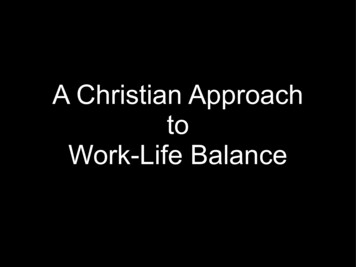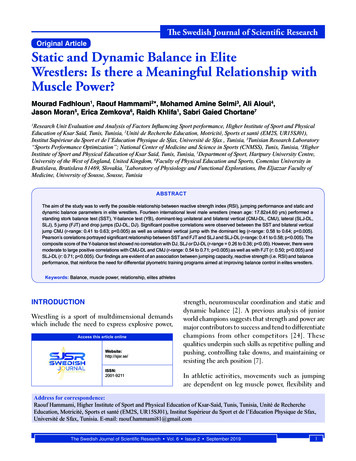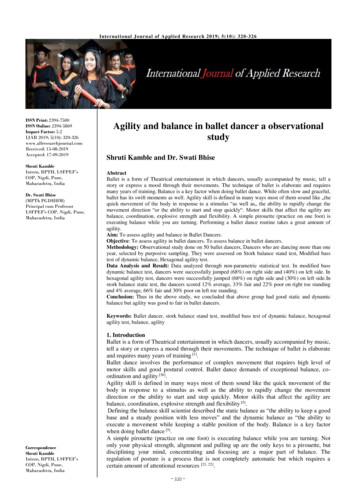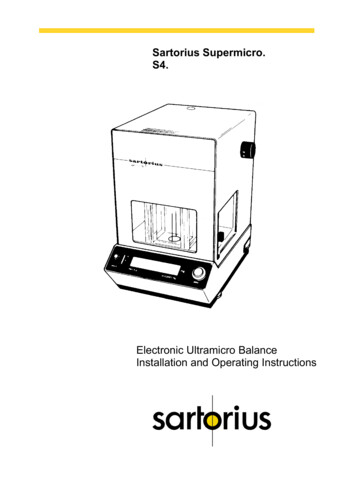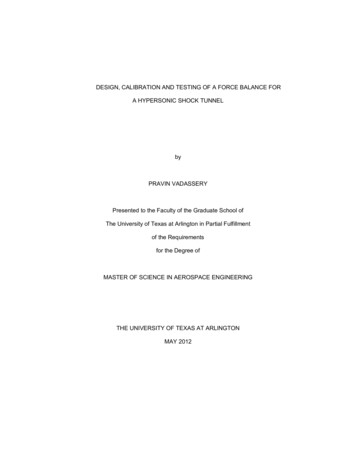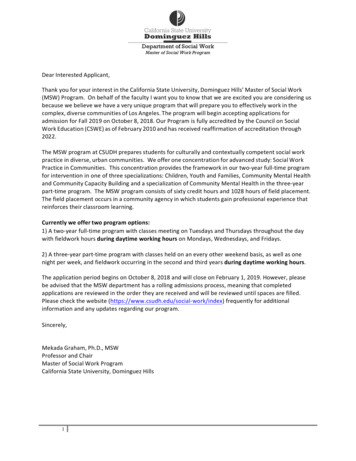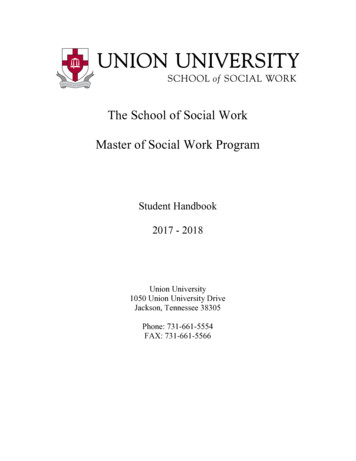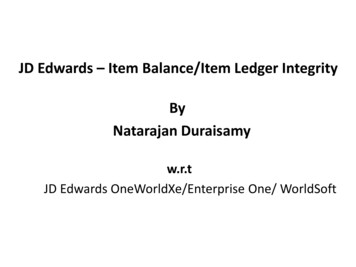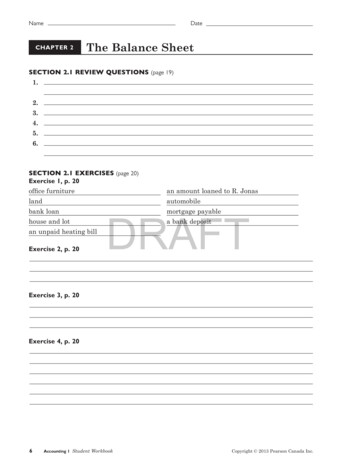
Transcription
International Journal of Research in Humanities and Social StudiesVolume 2, Issue 12, December 2015, PP 10-19ISSN 2394-6288 (Print) & ISSN 2394-6296 (Online)Work-Life Balance Challenges and Solutions: OverviewMr.D.Babin Dhas1, Dr.P.Karthikeyan2ABSTRACTIn organizations and on the home front, the challenge of work/life balance is rising to the top of manyemployers‟ and employees‟ consciousness. In today‟s fast-paced society, human resource professionals seekoptions to positively impact the bottom line of their companies, improve employee morale, retain employeeswith valuable company knowledge, and keep pace with workplace trends. This article provides human resourceprofessional with an historical perspective, data and possible solutions for organizations and employees alike towork/life balance. Three factors global competition, personal lives/family values, and an aging workforcepresent challenges that exacerbate work/life balance. This article offers the perspective that human resourceprofessionals can assist their companies to capitalize on these factors by using work/life initiatives to gain acompetitive advantage in the marketplace.Work/family: a term more frequently used in the past than today. The current trend is to use titles that includethe phrase work/life, giving a broader work/life connotation or labelling referring to specific areas of support(e.g., quality of life, flexible work options, life balance, etc.) Work/family conflict: the push and pull betweenwork and family responsibilities. Work/life balance from the employee viewpoint: the dilemma of managingwork obligations and personal/family responsibilities. Work/life balance from the employer viewpoint: thechallenge of creating a supportive company culture where employees can focus on their jobs while at work.Family-friendly benefits: benefits that offer employees the latitude to address their personal and familycommitments, while at the same time not compromising their work responsibilities.Work-life balance is about effectively managing the juggling act between paid work and other activities that areimportant to us - including spending time with family, taking part in sport and recreation, volunteering orundertaking further study. Research suggests that improving the balance between our working lives and ourlives outside work can bring real benefits for employers and employees. It can help build strong communitiesand productive businesses. In a society filled with conflicting responsibilities and commitments, work/lifebalance has become a predominant issue in the workplace. Three major factors contribute to the interest in, andthe importance of, serious consideration of work/life balance:Global competition; 2) renewed interest in personal lives/ family values; and 3) an aging workforce. Researchsuggests that forward-thinking human resource professionals seeking innovative ways to augment theirorganization‟s competitive advantage in the market- place may find that work/life balance challenges offer awin-win solution.THE GENESIS OF WORK/LIFE BALANCEWork/Life BalanceIn a state of equilibrium in which the demands of both a person‟s job and personal life are equal.Phrases and words serve as cultural signposts to explain where we are and where we are going. Theterm “work/life balance” was coined in 1986, al- though its usage in everyday language was sporadicfor a number of years. Interestingly, work/life pro- grams existed as early as the 1930s. Before WorldWar II,the W.K. Kellogg Company created four six-hour shifts to replace the traditional three dailyeight-hour shifts,and the new shifts resulted in increased employee morale and efficiency. Rosabeth1Mr.D.BABIN DHAS, Assistant Professor, Department of Management Studies, Loyola Institute ofTechnology, Chennai-600123. Email: babindhasmba@gmail.com, Mobile: 9994873783.2Dr.P.KARTHIKEYAN, Associate Professor, Department of Management Studies, Periyar University PGExtension Centre, Dharmapuri 636705. Email: s for correspondence:babindhasmba@gmail.comInternational Journal of Research in Humanities and Social Studies V2 I11 November 201510
Mr.D.Babin Dhas & Dr.P.Karthikeyan “Work-Life Balance Challenges and Solutions: Overview”Moss Kanter‟s seminal book (1977), Work and Family in the United States: A Critical Review andAgenda for Research and Policy,brought the issue of work/life balance to the forefront of research andorganizations.In the 1980s and 1990s, companies began to offer work/life programs. While the first wave of theseprograms were primarily to support women with children, today‟s work/life programs are less genderspecific and recognize other commitments as well as those of the family. Work/life balance initiativesare not only a U.S. phenomenon. Employees in global communities also want flexibility and controlover their work and per- sonal lives. However, for the purpose of this article, the research and surveyspresented focus on work/life balance in the United States.Defining Work/Life Balance Life is a balancing act, and in American society, it is safe to say thatalmost everyone is seeking work/life balance. But what exactly is work/life balance? We have allheard the term, and many of us complain that we don‟t have enough of it in our lives. Among menand women alike, the frustrating search for work/life balance is a frequent topic of conversation,usually translated into not enough time and/or support to do, to handle, to manage our workcommitments or personal responsibilities. “Juggling competing demands is tiring if not stressful andbrings lower productivity, sickness, and absenteeism, so work/life balance is an issue for allemployees and all organizations.”BENEFITS OF WORK-LIFE BALANCEBenefits for youEmployees in companies already implementing work-life practices enjoy significant benefits such as: Being able to effectively manage multiple responsibilities at home, work and in the communitywithout guilt or regret. Being able to work in flexible ways so that earning an income and managing family/othercommitments become easier. Being part of a supportive workplace that values and trusts staff.People want to be able to have: A good quality of life An enjoyable work life and career progression training and development Good health Affordable childcare or eldercare Further education More money Time to travel Time with friends and family Time to do sports and hobbies Time to do voluntary workWork/Life Balance: Challenges and SolutionsWork/life programs: programs (often financial or time-related) established by an employer that offeremployees options to address work and personal responsibilities. Work/life initiatives: policies andprocedures established by an organization with the goal to enable employees to get their jobs doneand at the same time provide flexibility to handle person- al/family concerns.Work/family culture: the extent to which an organization‟s culture acknowledges and respects thefamily responsibilities and obligations of its employees and encourages management and employeesto work together to meet their person- al and work needs.Personal Lives and Family Values to the Forefront the Indian work ethic remains intact, yet in recentyears personal and family lives have become critical values that most of the Indians are less willing toput on hold, put aside, or ignore, for the sake of work. Over time, the American workforce has begunto change course from being willing to spend every hour working to learning to manage theInternational Journal of Research in Humanities and Social Studies V2 I11 November 201511
Mr.D.Babin Dhas & Dr.P.Karthikeyan “Work-Life Balance Challenges and Solutions: Overview”complexities of modern living. In addition, the impact of the terrorist attacks of September 11 has ledmany people to re-evaluate their lives and consider the meaning of work. Consequently, Indians arelooking for options that allow for both a personal and family life, and many seek ways to have it all.As a result, the Indian management philosophy that expects employees to put work first, ahead ofpersonal lives and family commitments, is becoming less accepted. In a 2001 survey conducted bythe Public Policy Centre, 82% of men and 85% of women ages 20 to 39 placed family time at the topof their work/life priorities. In a 2006 study by Madras University and the University of Periyar, 90%of working adults said they are concerned they do not spend enough time with their families.The Changing Face of Family With the growing diversity of family structures represented in theworkforce in the new millennium, it is important that human resource professionals better understandthe interface of work and family relation- ships and the resulting impact in the workplace. Researchby Parasuraman and Greenhaus (2002) documented that segments of the workforce may be subject tounique work/family pressures, yet often have few sources of support. The under- representation ofthese groups of individuals with potentially difficult types of work/family pressures represents a majorgap in work/family research and employers‟ understanding of their needs. Typically, studies havefocused on employed men and women who are married or living with a partner or those with children.Omitted from research are single-earner mothers and fathers, single and childless employees withextensive responsibility for eldercare, blended families with children from both partners‟ priormarriages, families with shared custody of children, and grandparents raising their grandchildren.Swift, L. (2002). Work-life balance important in relief world, too. Reuters AlterNet. RetrievedJanuary 30, 2003, from http://www .alertnet.org/thefacts/reliefsources Parasuraman, S., & Greenhaus,J. H. (2002). Toward reducing some critical gaps in work-family research. Human ResourceManagement Review, 12, 3, 299-312.From both the employer and employee viewpoint, the changingnature of what constitutes family is one of the complications of today‟s society.As human resource professionals design policies and programs to address employee retention, jobsatisfaction, employee morale, and productivity, this research warrants serious consideration. APivotal Study In their highly acclaimed book, Work and Family—Allies or Enemies, Friedman andGreenhaus (2000),two leaders in work/life balance, bring forth new evidence to help us understandchoices we make as employers and individuals regarding work and family.5 This pioneering study ofmore than 800 business professionals considered values, work, and family lives and found that “workand family, the dominant life roles for most employed women and men in contemporary society, caneither help or hurt each other.”6 To handle work/life balance, Friedman and Greenhaus emphasizethat working adults learn to build networks of support at home, at work, and in the community.Conflict between work and family has real consequences and significantly affects quality of familylife and career attainment of both men and women. The consequences for women may include seriousconstraints on career choices, limited opportunity for career advancement and success in their workrole, and the need to choose between two apparent opposites an active and satisfying career ormarriage and children. Many men have to trade off personal and career values while they search forways to make dual- career families work, often requiring them to embrace family roles that are fardifferent, and more egalitarian, than those they learned as children.This research reveals a compensatory effect between two forms of psychological interference: workto-family and family-to-work. Specifically, support from two domains (partner and employer) has asignificant impact on one another. The impact of partner support is greater when businessprofessionals feel their employers are unsupportive of their lives beyond work. Conversely, foremployees with relatively unsupportive partners, the employer family-friendliness reduces roleconflicts more than partners. Thus, one source of support compensates for the lack of the other.Looking at behavioural interference of work on family, the picture changes. In this case, the whole isgreater than the sum of its parts: the combined impact of employer and partner support leads to agreater Reduction in conflict than does independent employer or partner support.Stress and the Consequences for Employer and Employee We live in stressful times, and each of usdeals with stress every day. In the past three years, an increasing number of employees surveyedindicate they are struggling with work/life balance. A work/life balance survey conducted in 2002 byTrue Careers states that 70% of more than 1,500 respondents said they don‟t have a healthy balancebetween their personal and work lives.“Holding a Job, Having a Life: Strategies for Change” 2001 study by the Work Institute of Americapoints out that employee-driven solutions help reduce overtime, stress, and workloads, and increase12International Journal of Research in Humanities and Social Studies V2 I11 November 2015
Mr.D.Babin Dhas & Dr.P.Karthikeyan “Work-Life Balance Challenges and Solutions: Overview”flexibility and family and leisure time. Scientists agree that in moderate amounts stress can be benign,even beneficial, and most people are equipped to deal with it. However, increasing levels of stress canrapidly lead to low employee morale, poor productivity, and decreasing job satisfaction. Some of thespecific symptoms that relate directly to productivity in the work environment are abuse of sick time,cheating, chronic absenteeism, distrust, embezzlement, organizational sabotage, tardiness, taskavoidance, and violence in the workplace. Other serious repercussions are depression, alcohol anddrug abuse, marital and financial problems, compulsive eating disorders, and employee burnout.Dr. Bruce S. McEwen, director of the neuroendocrinology laboratory
Work-Life Balance Challenges and Solutions: Overview Mr.D.Babin Dhas1, Dr. P.Karthikeyan 2 ABSTRACT In organizations and on the home front, the challenge of work/life balance is rising to the top of many employers‟ and employees‟ consciousness. In today‟s fast-paced society, human resource professionals seek options to positively impact the bottom line of their companies, improve .
